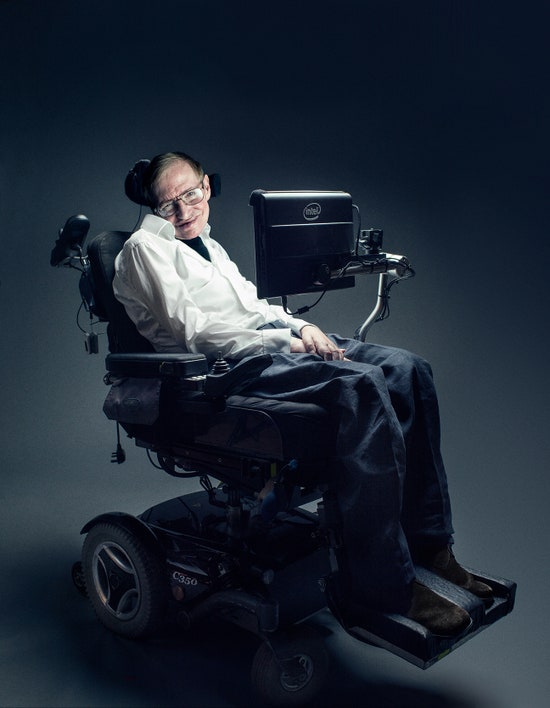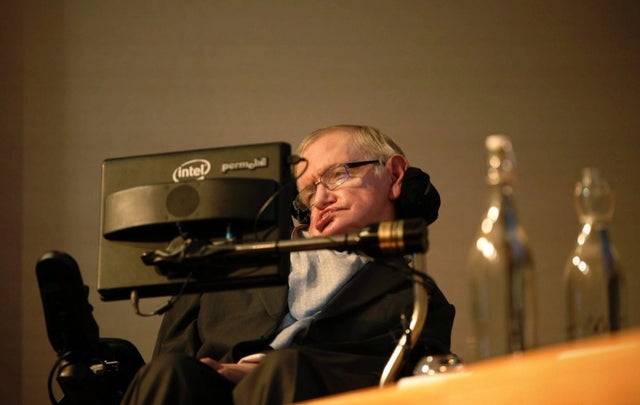Stephen Hawking Timeline
 Stephen Hawking (8 January 1942 – 14 March 2018) was an English theoretical physicist, cosmologist, and author who was director of research at the Centre for Theoretical Cosmology at the University of Cambridge at the time of his death.
With regards to his lifetime of work, he collaborated with Roger Penrose on gravitational singularity theorems in the framework of general relativity. He further theorized that black holes emit radiation, often called Hawking radiation, and was the first to set out a theory of cosmology explained by a union of the general theory of relativity and quantum mechanics.
After receiving a first-class BA (Hons.) degree in physics and completing a trip to Iran with a friend, he began his graduate work at Trinity Hall, Cambridge, in October 1962.
He had met his future wife, Jane Wilde, at a party that same year. The following year, Hawking was diagnosed with motor neurone disease. In October 1964, the couple became engaged to marry, aware of the potential challenges that lay ahead due to Hawking's shortened life expectancy and physical limitations. The two were married on 14 July 1965 in their shared hometown of St Albans. While his life expectancy was initially estimated at two years, the disease was found to be an early-onset but slow-progressing form. Hawking later said that the engagement gave him "something to live for". The couple had three children: Robert, born May 1967, Lucy, born November 1969, and Timothy, born April 1979.
Upon his appointment in 1974 to a year-long position at the California Institute of Technology in Pasadena, California, Jane proposed that a graduate or post-doctoral student live with them and help with his care, a situation that became permanent.
In the late 1980s, Hawking grew close to one of his nurses, Elaine Mason, to the dismay of some colleagues, caregivers, and family members, who were disturbed by her strength of personality and protectiveness. Elaine left her husband of 15 years and their two children. In February 1990, Hawking told Jane that he was leaving her for Mason, and departed the family home. After their divorce was finalized five years later, Hawking married Mason in September 1995. Jane then married Jonathan Jones in 1997. Jonathan had been the organist in the church when they'd first met in 1977 and though they grew close, they were both "determined not to break up the family, and their relationship had remained platonic for a long period".
In 2006, Hawking and Mason quietly divorced, and Hawking resumed closer relationships with Jane, his children, and his grandchildren, until his death in 2018.
Stephen Hawking (8 January 1942 – 14 March 2018) was an English theoretical physicist, cosmologist, and author who was director of research at the Centre for Theoretical Cosmology at the University of Cambridge at the time of his death.
With regards to his lifetime of work, he collaborated with Roger Penrose on gravitational singularity theorems in the framework of general relativity. He further theorized that black holes emit radiation, often called Hawking radiation, and was the first to set out a theory of cosmology explained by a union of the general theory of relativity and quantum mechanics.
After receiving a first-class BA (Hons.) degree in physics and completing a trip to Iran with a friend, he began his graduate work at Trinity Hall, Cambridge, in October 1962.
He had met his future wife, Jane Wilde, at a party that same year. The following year, Hawking was diagnosed with motor neurone disease. In October 1964, the couple became engaged to marry, aware of the potential challenges that lay ahead due to Hawking's shortened life expectancy and physical limitations. The two were married on 14 July 1965 in their shared hometown of St Albans. While his life expectancy was initially estimated at two years, the disease was found to be an early-onset but slow-progressing form. Hawking later said that the engagement gave him "something to live for". The couple had three children: Robert, born May 1967, Lucy, born November 1969, and Timothy, born April 1979.
Upon his appointment in 1974 to a year-long position at the California Institute of Technology in Pasadena, California, Jane proposed that a graduate or post-doctoral student live with them and help with his care, a situation that became permanent.
In the late 1980s, Hawking grew close to one of his nurses, Elaine Mason, to the dismay of some colleagues, caregivers, and family members, who were disturbed by her strength of personality and protectiveness. Elaine left her husband of 15 years and their two children. In February 1990, Hawking told Jane that he was leaving her for Mason, and departed the family home. After their divorce was finalized five years later, Hawking married Mason in September 1995. Jane then married Jonathan Jones in 1997. Jonathan had been the organist in the church when they'd first met in 1977 and though they grew close, they were both "determined not to break up the family, and their relationship had remained platonic for a long period".
In 2006, Hawking and Mason quietly divorced, and Hawking resumed closer relationships with Jane, his children, and his grandchildren, until his death in 2018.
Stephen Hawking, the Apple II and the speech synthesizer
Hawking lost his ability to speak in 1985, when, on a trip to CERN in Geneva, he caught pneumonia. In the hospital, he was put on a ventilator. His condition was critical. The doctors asked Hawking's then-wife, Jane, whether they should turn off the life support. She vehemently refused. Hawking was flown to Addenbrooke's Hospital, in Cambridge, where the doctors managed to contain the infection. To help him breathe, they also performed a tracheotomy, which involved cutting a hole in his neck and placing a tube into his windpipe. As a result, Hawking irreversibly lost the ability to speak.
For a while, he communicated using a spelling card, patiently indicating letters and forming words with a lift of his eyebrows.
In 1986, Martin King, a physicist who had been working with Hawking on a new way of communicating, contacted a California-based company called Words Plus, whose computer program Equalizer allowed the user to single out words and commands via a menu system on a computer by using a hand clicker. King spoke to the CEO of Words Plus, Walter Woltosz, and asked if the software could help a physics professor in England with ALS. Woltosz had created an earlier version of Equalizer to help his mother-in-law, who also suffered from ALS and had lost her ability to speak and write. "I asked if it was Stephen Hawking, but he couldn't give me a name without permission," says Woltosz. "He called me the next day and confirmed it. I said I would donate whatever was needed."
Equalizer first ran on an Apple II computer linked to a speech synthesizer made by a company called Speech Plus. This system was adapted by David Mason, at the time the engineer husband of one of Hawking's nurses, for use on the scientist's wheelchair arm. With this new system, Hawking was able to communicate at a rate of 15 words per minute.
The synthethised voice which then became synonymous with Stephen Hawking, had been created in 1984 by Dennis Klatt, an engineer at the Massachusetts Institute of Technology and a pioneer of text-to-speech algorithms. Called the DECtalk, it was one of the first devices to translate text into speech. He initially made three voices, from recordings of his wife, daughter and himself. The female's voice was called "Beautiful Betty", the child's "Kit the Kid", and the male voice, based on his own, "Perfect Paul".
"Perfect Paul", the default adult male option on the DECtalk then became Hawking's voice.
When he was given a new speech synthesiser in 1988, Prof Hawking disliked the new voice and asked for Perfect Paul to be returned. "I keep it because I have not heard a voice I like better and because I have identified with it," he said in 2006.
He'd once considered using a machine which gave him a French accent, but decided against it as his then-wife would divorce him, he joked.
Stephen Hawking, and Intel

|
|
Tech giant Intel started working with Professor Hawking in 1997 (Photo: Getty)
|
|
STEPHEN HAWKING FIRST met Gordon Moore, the cofounder of Intel, at a conference in 1997. Moore noticed that Hawking's computer (no longer an Apple II) had an AMD processor and asked him if he preferred instead a "real computer" with an Intel micro-processor. Intel has been providing Hawking with customized PCs and technical support since then, replacing his computer every two years.
However, the nerve that allowed him to move his thumbs kept degrading. By 2008, Hawking's hand was too weak to use the clicker. His graduate assistant at the time then devised a switching device called the "cheek switch." Attached to his glasses, it could detect, via a low infrared beam, when Hawking tensed his cheek muscle.
Hawking's computer interface by then had become a program called EZ Keys, an upgrade from the previous softwares and also designed by Words Plus. It provided him with a keyboard on the screen and a basic word-prediction algorithm. A cursor automatically scanned across the keyboard by row or by column and he could select a character by moving his cheek to stop the cursor. EZ Keys also allowed Hawking to control the mouse in Windows and operate other applications in his computer. He surfed the web with Firefox and wrote his lectures using Notepad. He also had a webcam that he used with Skype.
All was done using only one muscle. Nevertheless, his ability to communicate continued to decline. By 2011, he managed only about one or two words per minute, so he sent a letter to Moore, saying: "My speech input is very, very slow these days. Is there any way Intel could help?"
In 2014 the new system, Assistive Context-Aware Toolkit (ACAT), was complete. Intel had partnered with British software startup SwiftKey to reduce the number of characters Prof Hawking was required to input before a word was suggested, speeding up the execution of common tasks ten-fold.
"ACAT includes a word prediction algorithm provided by SwiftKey, trained on my books and lectures, so I usually only have to type the first couple of characters before I can select the whole word. When I have built up a sentence, I can send it to my speech synthesiser," Prof Hawking wrote on his website. "It is the best I have heard, although it gives me an accent that has been described variously as Scandinavian, American or Scottish."
Despite all the technological advances in his communications software, Professor Hawking used his 1988 Speech Plus CallText 5010 synthesiser until his death.
References
Go Top
** End of file
 Stephen Hawking (8 January 1942 – 14 March 2018) was an English theoretical physicist, cosmologist, and author who was director of research at the Centre for Theoretical Cosmology at the University of Cambridge at the time of his death.
With regards to his lifetime of work, he collaborated with Roger Penrose on
Stephen Hawking (8 January 1942 – 14 March 2018) was an English theoretical physicist, cosmologist, and author who was director of research at the Centre for Theoretical Cosmology at the University of Cambridge at the time of his death.
With regards to his lifetime of work, he collaborated with Roger Penrose on 